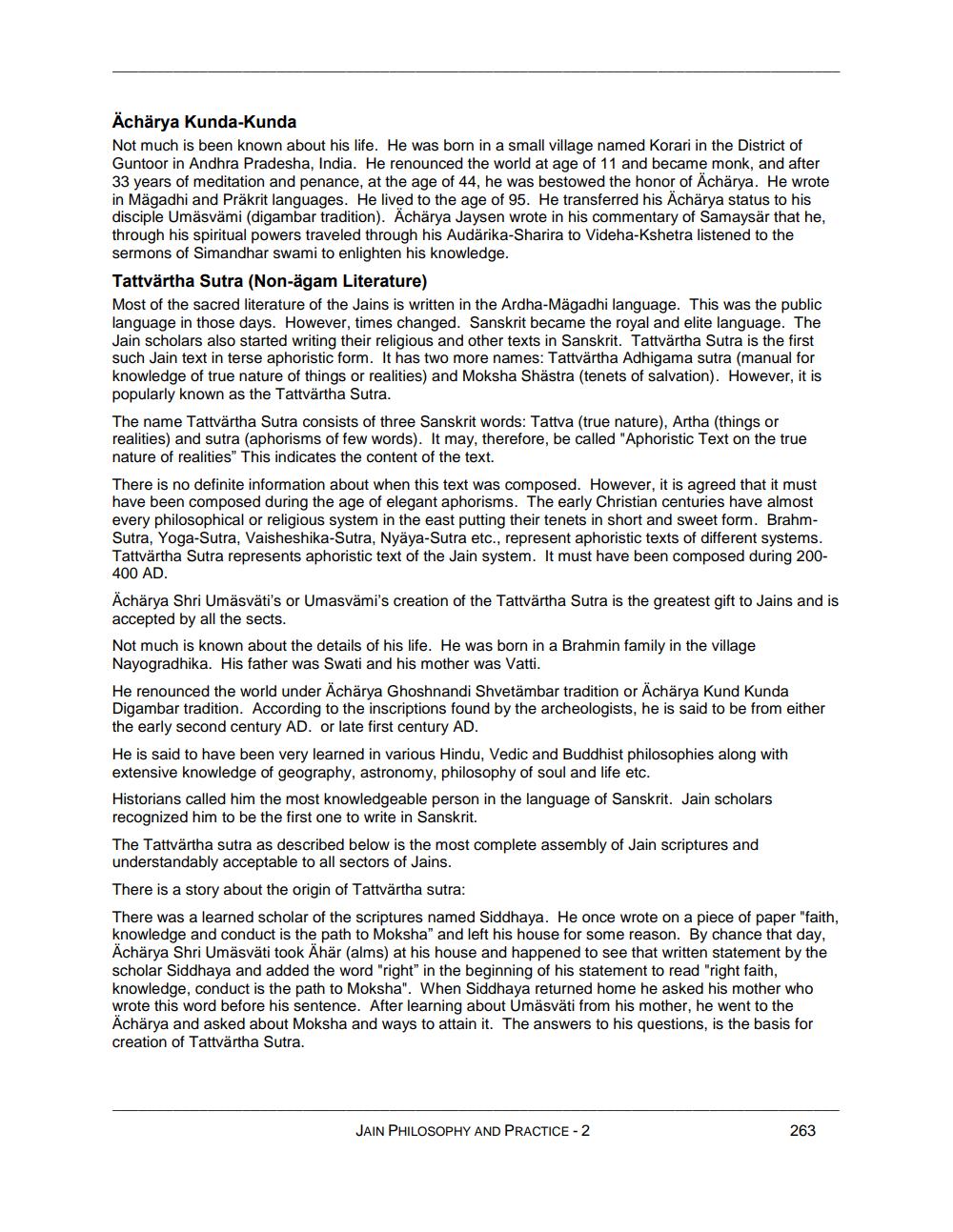________________
Acharya Kunda-Kunda Not much is been known about his life. He was born in a small village named Korari in the District of Guntoor in Andhra Pradesha, India. He renounced the world at age of 11 and became monk, and after 33 years of meditation and penance, at the age of 44, he was bestowed the honor of Acharya. He wrote in Mägadhi and Präkrit languages. He lived to the age of 95. He transferred his Achärya status to his disciple Umäsvämi (digambar tradition). Acharya Jaysen wrote in his commentary of Samaysär that he, through his spiritual powers traveled through his Audärika-Sharira to Videha-Kshetra listened to the sermons of Simandhar swami to enlighten his knowledge. Tattvärtha Sutra (Non-ägam Literature) Most of the sacred literature of the Jains is written in the Ardha-Mägadhi language. This was the public language in those days. However, times changed. Sanskrit became the royal and elite language. The Jain scholars also started writing their religious and other texts in Sanskrit. Tattvärtha Sutra is the first such Jain text in terse aphoristic form. It has two more names: Tattvärtha Adhigama sutra (manual for knowledge of true nature of things or realities) and Moksha Shastra (tenets of salvation). However, it is popularly known as the Tattvärtha Sutra. The name Tattvärtha Sutra consists of three Sanskrit words: Tattva (true nature), Artha (things or realities) and sutra (aphorisms of few words). It may, therefore, be called "Aphoristic Text on the true nature of realities" This indicates the content of the text. There is no definite information about when this text was composed. However, it is agreed that it must have been composed during the age of elegant aphorisms. The early Christian centuries have almost every philosophical or religious system in the east putting their tenets in short and sweet form. BrahmSutra, Yoga-Sutra, Vaisheshika-Sutra, Nyaya-Sutra etc., represent aphoristic texts of different systems. Tattvärtha Sutra represents aphoristic text of the Jain system. It must have been composed during 200400 AD. Acharya Shri Umäsväti's or Umasvämi's creation of the Tattvärtha Sutra is the greatest gift to Jains and is accepted by all the sects. Not much is known about the details of his life. He was born in a Brahmin family in the village Nayogradhika. His father was Swati and his mother was Vatti. He renounced the world under Acharya Ghoshnandi Shvetämbar tradition or Achärya Kund Kunda Digambar tradition. According to the inscriptions found by the archeologists, he is said to be from either the early second century AD. or late first century AD. He is said to have been very learned in various Hindu, Vedic and Buddhist philosophies along with extensive knowledge of geography, astronomy, philosophy of soul and life etc. Historians called him the most knowledgeable person in the language of Sanskrit. Jain scholars recognized him to be the first one to write in Sanskrit. The Tattvärtha sutra as described below is the most complete assembly of Jain scriptures and understandably acceptable to all sectors of Jains. There is a story about the origin of Tattvärtha sutra: There was a learned scholar of the scriptures named Siddhaya. He once wrote on a piece of paper "faith, knowledge and conduct is the path to Moksha" and left his house for some reason. By chance that day, Acharya Shri Umäsväti took Ahär (alms) at his house and happened to see that written statement by the scholar Siddhaya and added the word "right" in the beginning of his statement to read "right faith, knowledge, conduct is the path to Moksha". When Siddhaya returned home he asked his mother who wrote this word before his sentence. After learning about Umäsväti from his mother, he went to the Acharya and asked about Moksha and ways to attain it. The answers to his questions, is the basis for creation of Tattvärtha Sutra.
JAIN PHILOSOPHY AND PRACTICE - 2
263




